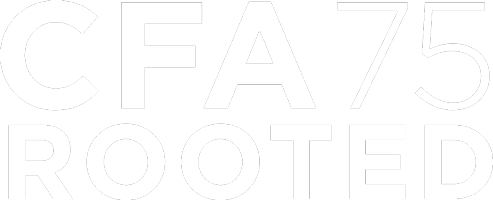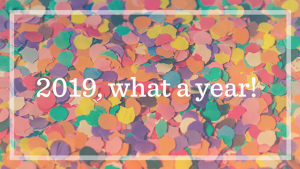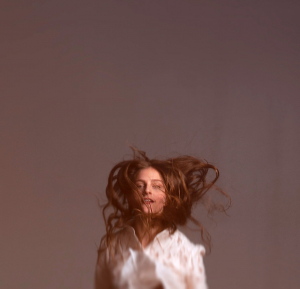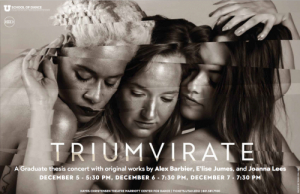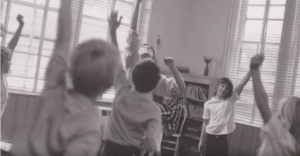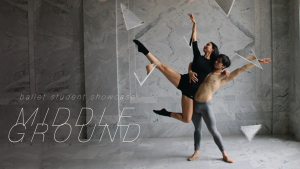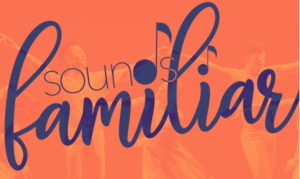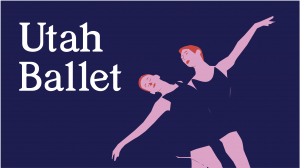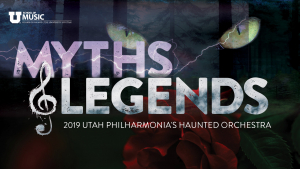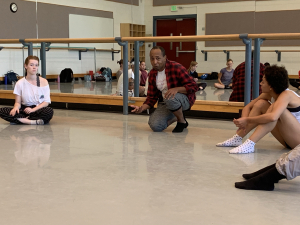Displaying items by tag: School of Dance
Looking back on 2019
2019 is coming to a close! While we all look forward to a bright and promising beginning to 2020 (we see you, resolutions), let’s take a moment to reflect on the incredible accomplishments of this past semester. During 2019, each of our five academic units pushed boundaries, reached new heights, made new discoveries and had quite a bit of fun in the process. In short, we have plenty to celebrate.
Here are just a few highlights:
College of Fine Arts
- Our annual Arts Bash celebration filled the library plaza with bustling creative energy as students discovered campus arts organizations, explored non-major courses, screenprinted t-shirts with original designs and enjoyed live performances.
- At the CFA Gala in Kingsbury Hall, we honored distinguished alumni Claybourne Elder, Tauna Hunter and Jonathan Hale. It was a night filled with intergenerational mingling, performances, reflections and dessert!
- The Arts-In-Health Innovation Lab hosted the 2019 Arts in Health Symposium at the Beverley Taylor Sorenson Arts and Education complex. This exciting afternoon incorporated keynote addresses by nationally recognized art-in-health leaders Jill Sonke, Lora Gooding and Debra Burns.
- FAF Grants were awarded to several student-led organizations and intitiatives including: Sculpture Club, Great Salt Lake Low Brass Society, Modern Dance Student Concert Committee, Animation Crew, CNAfME, Under Pressure, and more.
Department of Art & Art History
- Student work was publically exhibited in the Howard Clark Scholarship Exhibition, MFA open studios, Kathryn Wingard's "A Loving Struggle," the Holiday Art Sale, This Is Not A Furniture Show Pop-up, and Objects of Desire and Disgust.
- Many of our faculty and alumni were featured artists in the inaugural Wasatch Studio Tour which showcased 100 registered artists over 20 mediums.
- Students discovered contemporary works on paper at the Paperwest Exhibition and explored new techniques and innovative directions at the 5th Rocky Mountain Printmaking Alliance Symposium, "Transposing Attitudes."
- The department hosted wonderful guest artists Erik Brandt, Carmen Winant, Shaye Remba, Ashley Eliza Williams, and Amy Irvine.
- Visiting artists Charles O. Anderson and Omar Carrum set choreography in collaboration with School of Dance students, presented in the fall concert of Performing Dance Company with works from Satu Hummasti and Daniel Clifton.
- Student-led performances "MIDDLEGROUND," "Triumvirate" and the Modern Student Concert featured the voices of our student artists.
- At the School of Music's Camerata Awards Gala, School of Dance students performed a flash mob as attendees entered the concert hall.
- Repertory Dance Theatre's “Sounds Familiar” featured original choreography from department chair Luc Vanier, assistant professor (Lecturer)Sara Pickett, faculty emeritus Stephen Koester, faculty emeritus Sharee Lane, assistant professor Molly Heller and several dance alumni.
Department of Film & Media Arts
- The College of Fine Arts welcomed Andrew Patrick Nelson, PhD as the new chair of the Department of Film & Media Arts.
- In an exciting new report, College Factual ranked the Department of Film & Media Arts in the top 20 film programs nationwide, and 5th for value.
- The annual F&MAD Fest at Tower Theatre featured ten handpicked student films for the public to enjoy. The jury awarded Stepp Chatterly for Winning Script, Summer Florence for Best Undergraduate Film, and Bethany Joy Burr for Best Graduate Film.
- Students enrolled in Producing and Directing (Capstone course) pitched their projects to an amazing panel of judges. The Best Pitch - Jury Award went to Sam Raines and The Best Pitch - Peers Award to Jacob Greene.
- Producer-in-Residence Emelie Mahdavian screened her award winning documentary "MIDNIGHT TRAVELER' on campus, followed by a Q&A with attendees.
- Students from Wuhan University joined Utah Philaharmonia in a special evening of cross-cultural music traditions, directed by Robert Baldwin.
- School of Music percussion students were featured at the Percussive Arts Society International Convention (PASIC) in Indianapolis, IN, performing a student composition.
- "Composing Community in Late Medieval Music: Self-Reference, Pedagogy and Practice," a monograph by assistant professor of musicology, Jane Hatter was published by Cambridge University Press.
- The annual Camerata Awards gala featured many student performances and honored Bruce W. Bastian and Loel T. Hepworth.
- The Department of Theatre kicked off the 2019-2020 season with three fabulous productions: "Dracula, The Musical," "Macbeth," and "The Odyssey."
- Students, faculty, and professionals from all over the state of Utah participated in the first statewide Intimacy Directing Workshop hosted by the University of Utah Department of Theatre. Through the guidance of Intimacy Directors International (IDI) instructors Jessica Steinrock and Rachel Flesher, the workshops explored choreography techniques and broad self-care strategies to introduce and integrate intimacy practice with an emphasis on consent in the rehearsal and performance space for all who participate.
- Students from all different disciplines collaborated to build original puppets for "She Kills Monsters," opening in January at Kingsbury Hall.
- Alumni and broadway actor Claybourne Elder worked with students one-on-one in a special workshop.
From all of us at the CFA, we celebrate this fantastic semester and eagerly look toward the spring! Happy New Year!
MAKING ART WORK: No. 22, Choreographer & Dancer Rebecca Aneloski
MAKING ART WORK is a series that taps into the knowledge and experience of seasoned creatives from our community and beyond for the benefit of our students.
Rebecca Aneloski is a performing artist and freelance choreographer based in Salt Lake City, Utah. Originally from Colorado, Aneloski earned her BFA in Ballet from Friends University and her MFA from the School of Dance at the University of Utah. In her dance project, And Artists, focuses on collaborative choreographic process with SLC dance artists. Recently, Aneloski was awarded New Century Dance Project's Professional and Emerging Choreographer award and she was selected as a commissioned choreographer for Repertory Dance Theatre. She will premiere her new work for the company early in 2020. And Artists will also premiere their newest work in February at Ultraviolet Studios. Aneloski currently performs in SONDERimmersive's "Thank You Theobromine."
What are you working on currently?
I’m currently creating movement with And Artists, a Salt Lake City-based dance project that I began last year. I began this project so there could be more opportunities for myself and a few friends. I wanted space to keep dancing, creating and a name that included all of us who contributed to the work. There are so many talented dance artists that live in SLC, and And Artists became my way of continuing the practice of creating dances and researching with dancers in the area.
In February, we are creating an intimate gathering of 30 people at Ultraviolet Studios alongside Mella, a company in SLC that will be bringing small tastes of food and wine to this evening. Secondly, I’m working for SONDERimmersive as a collaborative choreographer, writer, and artist. The work, “Thank you Theobromine”, is created by Graham Brown and Rick Curtiss. The show is in collaboration with Salt Lake’s The Chocolate Conspiracy, founded by chocolate maker AJ Wentworth. It’s been a good push for me to experience a different way to bring a story to an audience. Stepping into a creative process that melds physical movement and theater has been all the things from vulnerable, humbling and empowering. I’m new to the immersive experience and I’m discovering that with each day in process with the show and cast, my understanding and comfort level is expanded.
Are there particular themes that have been guiding/appearing in your recent choreography?
For this specific work coming up in February, I’ve been fascinated by the simplicity and the statement this type of stripped-down movement can create. This is the very opposite of my normal questions while making dances. I typically enjoy pushing difficulty, complexity, and speed in my works so to slow down and create more time and space for the simple while making it, hopefully, interesting and impactful to watch, will be my goal.
How do you stay inspired? 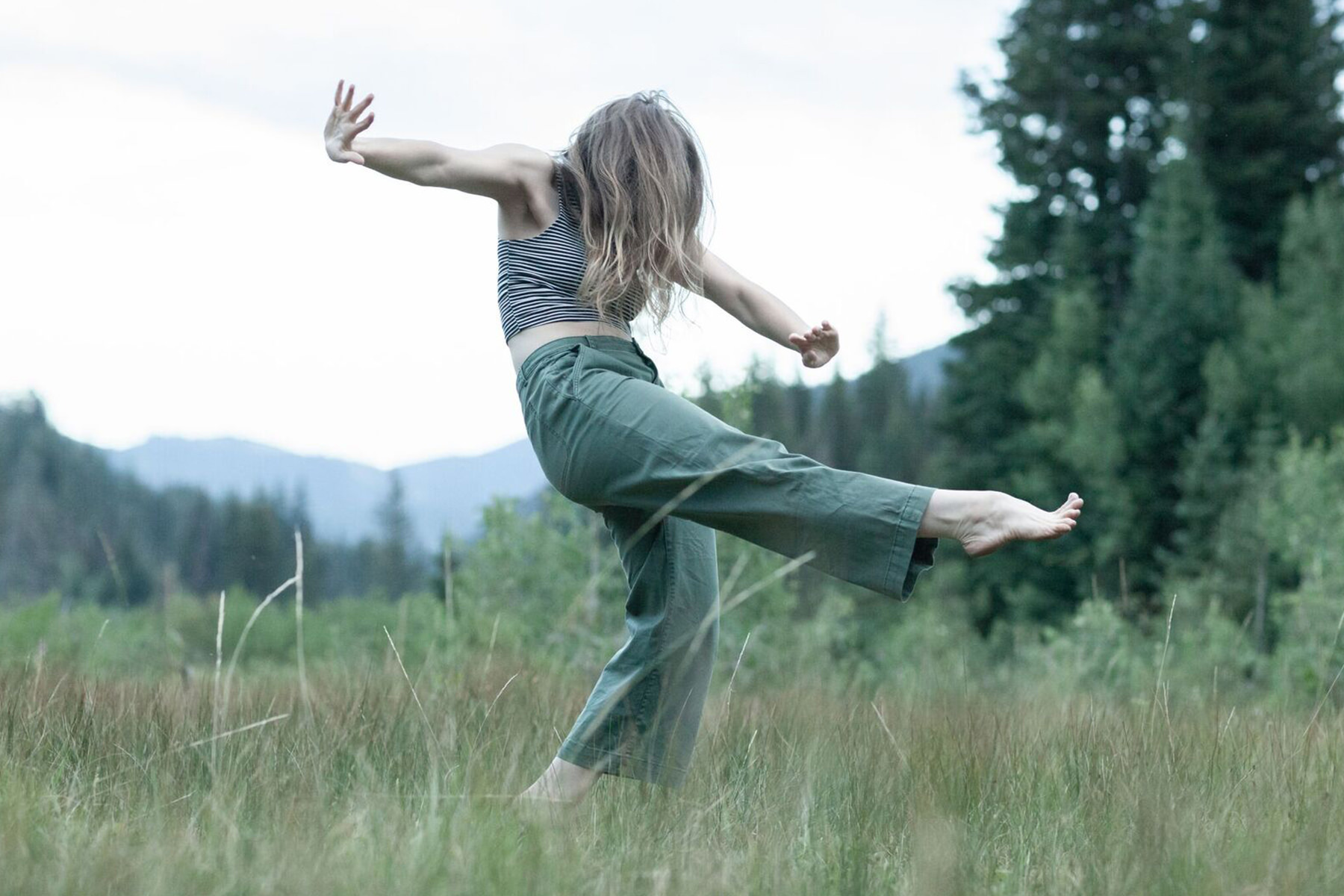 Photo: Erica MacLean
Photo: Erica MacLean
For me, it’s not about staying inspired but committing to the project and seeing it through till the end. I hope inspiration stays with me after I begin but most times it comes and goes, and that’s okay. For the sake of the question, I’ll say that staying inspired best happens by having enough mental and physical space to maintain creativity, and a sense of play, a willingness to explore movement. I read a lot of books that have nothing to do with dance and try to disconnect from what dance artists are doing and saying in the field. This was not the case while I was in grad school at the U but for now this has helped me to hear my own ideas clearer.
I spend a lot of time in silence, cultivating time unconnected from screens. I’ve started this practice because I found I was too influenced by social media, youtube clips, and comparison. This seemed the best solution for now. Taking walks when I can and allowing time to be around others in my community that is in transition and live in transition often brings ideas that inspire themes in my work. Also, I find it crucial to be in conversation with other artists from different mediums. This has been a huge encouragement and motivation in transforming how I think of movement and also how to create dances.
Well then, it seems I did have a lot to say.
Unexpected challenges of your profession?
It’s not unexpected, but continuing to be a choreographer building work outside of the facilities and extra perks provided by a company or university has been a massive struggle and complication. If you don’t teach or have prior connections to a studio owner space can be a ridiculous price per hour. Finding the funds when you are starting out has been an issue. Figuring out how to value the dancers I work with And Artists, finding space, while producing a show, well let’s just say that many unexpected challenges arise while trying to juggle it all while building these opportunities for oneself. Every time I begin a new process I wonder why I began in the first place. There is too much chaos but it’s something I begin to organize and sort out. Overall however I would say that staying honest through all of this is the most difficult challenge.
Do you have any rituals/routines/practices that are essential to your success?
No. Each process is new to me. Every time I begin with a new method.
What do you wish dancers were talking more about?
There is too much talk in my opinion. We need more listening and understanding in this art form and as people.
Follow Rebecca Aneloski's work at @and_artists on instagram and via her website.
Graduating Modern MFA Students Present "Triumvirate"
On December 5th, 6th, and 7th, in their final year of study at the University of Utah, the graduate students in the Modern Dance Masters of Fine Arts Program, invite you to attend "Triumvirate," their thesis concert in the Marriott Center for Dance’s Hayes Christensen Theater.
This culminating performance reveals the diverse creative research undertaken by the graduating students over the past three years.
In "Take This With You," Alexandra Barbier presents an interactive solo and group installation performance, which aims to disrupt the existing traditional relationships and roles between dance audiences and artists.
"Parachute Princess" is an intimate, interdisciplinary duet by E’lise Jumes. This research uses movement and sound to find what emerges when memory is used to create knowledge -- then resulting in realizations and constructed narratives of a multi-faceted self.
Joanna Lees presents "B E C O M I N G," which portrays a dynamic group of sixteen women manifesting power in the body by pushing the limits of their physical capacities. The work explores how empowerment can be achieved through superheroine narratives, concepts, themes, and physical ideas.
"Triumvirate" runs approximately 90 minutes long, and is free and open to the public.
Performance times include:
Thurs. 12/5 @ 5:30pm
Fri. 12/6 @ 7:30pm
Sat. 12/7 @ 7:30pm.
By Emeri Fetzer
In her 28 years as head of East High School's dance program, School of Dance alumna Connie Jo (CJ) Hepworth-Woolston had abundant occasions to witness firsthand the joy and meaning the arts can bring to education.
First introduced to dance in its many forms (ballet, modern, and tap) by her high school drama teacher, Hepworth-Woolston was hooked at an early age. At 15, she began teaching for Salt Lake County Recreation. She took the job seriously, organizing fully staged performances so her students could gain real world experience. She searched JC Penney for the perfect patterns for hand-sewn costumes. These community shows were the first in a long line of productions in which she would have an integral hand.
Earning two modern dance degrees from the University of Utah's College of Fine Arts (BFA 1958; MFA 1967), Hepworth-Woolston was well prepared both to perform and to teach dance to students of all ages. When a dance teaching position opened up at East High School that was promptly filled by an unqualified candidate, she fought hard to have the superintendent reconsider the hire. Photo: Busath Photography
Photo: Busath Photography
“I had my education in dance from the University of Utah, which was such a strong program. I just felt I should be teaching dance.”
She only briefly left East to pursue her master’s degree around the same time Shirley Ririe and Joan Woodbury were leaving the University of Utah to start their company, Ririe Woodbury Dance Company. Hepworth-Woolston performed with Ririe Woodbury in its earliest years and taught classes in the U’s dance department. But her heart never left East High School and she soon returned.
The blend of student mentorship, freedm to design curriculum, and opportunites to choreograph made for the ideal environment for Hepworth-Woolston. “I got to be my own boss at East. I taught the students the parts of dance history I thought were most relevant to them, I taught them meditation and relaxation during test week, techniques I had learned from Anne Halprin (postmodern dance pioneer). I taught them Israeli folk dance...” she said.
She choreographed “The Pajama Game,” “The King and I,” “Oklahoma,” “Bye Bye Birdie,” “Once Upon a Mattress,” “Finian’s Rainbow,” and was selected by Pioneer Theatre Company to design and choreograph their bicentennial production.
Truly a force for dance in the Salt Lake community, she served on the Utah Arts Council for six years, acting as chair for two. During that time, the city renovated what we now know as Abravanel Hall, and Hepworth-Woolston planned the outdoor ceremony for the opening of the new venue. Careful to be inclusive of the community at large, and to let music take center stage, she had a brass rendition of “Fanfare For The Common Man” ring out to the public.
“I wanted even little older ladies in tennis shoes to be able to come to the ribbon cutting,” she said. “So many people came they lined up on all the stairways…It was one of my favorite things I ever did.”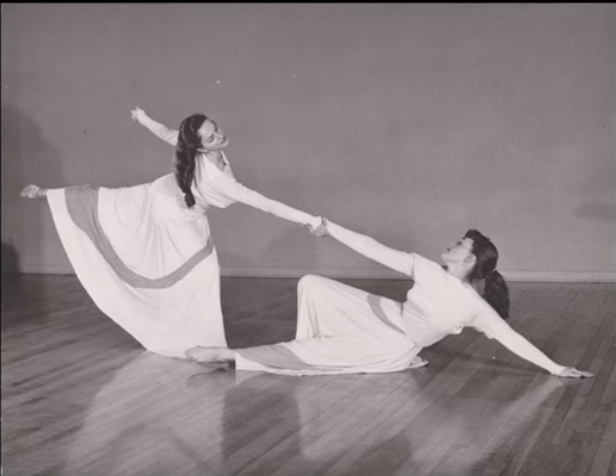 Connie Jo Hepworth-Woolston and Cynthia Jones
Connie Jo Hepworth-Woolston and Cynthia Jones
When she was invited by revered choreographers Alwin Nikolai and Murray Louis to be on the team for an inaugural Artists in Schools program, she jumped at the chance. As one of the first teachers to bring dance to schools across America, she taught in 18 states, applying dance to a broad range of academic subjects, from the water cycle to the use of the comma.
In one particularly fond memory, Hepworth-Woolston was tasked to work with a group of kids in Alabama who had been deemed “hyperactive” by their classroom teacher.
“I had them run first, and then I asked them to freeze, to not even move their eyeballs,” she explained. “It was so amazing. Pretty soon, these beautiful statues started to melt. They learned they could hold really still -- even with someone in front of them making faces, even with their friends laughing, they could be in control.”
When their teacher saw them calmly lying on the floor, she was amazed.
Because of her unwavering conviction that “the arts are healing,” Hepworth-Woolston continues to provide wider access to the arts in Utah and across the country. She is delighted to watch the University of Utah continue to train world-class arts educators who will carry on this important work.
“Letting students see themselves in a whole new way, it’s so exciting! I want to do it again.”
The School of Music is honoring Connie Jo and her late husband, Loel Hepworth, with a 2019 Camerata Award on Friday, November 22, 2019.
Click here for more information!
11 fresh dances presented in MIDDLEGROUND
By Brooke Elizabeth Wertwijn
The School of Dance students present a wide range of styles, voices, and stories in MIDDLEGROUND. Within the broad spectrum of eclectic works, eleven choreographers have put together a cohesive show with something for everyone. While some students have had experience choreographing before, for many, this is their first time presenting their work on the stage. As these young artists move from the role of dancer to choreographer, their choreographic voices offer insights into the subject matters that inspire them to speak through dance.
Juliana Godlewski, a senior in the ballet program, found inspiration for her piece, entitled “Pointe ‘n Boogie,”in classic disco movies and footage of disco competitions she found online. Godlewski describes her movement vocabulary as having “a contemporary ballet base with a variety of disco funk influences.” Set to music by Donna Summers, the Bee Gees, and Hot Chocolate, the dancers seem to have stepped right out of Saturday Night Fever. She continues, "I wanted to channel a night out at the disco...sequins, sweat, killer dance moves, glitter, vogueing, mascara streaming down your cheeks at 2 am, the Bee Gees... this is Pointe ‘n Boogie." Godlewksi’s choreography will make you want to jump out of your seat and start grooving with the dancers.
Many choreographers investigate their own curiosities about life through their choreographic process. Sydney May’s new work, “The Matter of Time,” is a deep, personal study on our relationship to time. She describes the central idea of her piece as an exploration of the “paralytic polarization of the past and future that results in the suppressed progression as a part of the human condition.” This complex idea is artfully embodied in May’s choreography by her three dancers. Each dancer’s individually distinct movement vocabulary push and pull on one another creating a sense of tension between our past and future selves. Her work invites the audience to consider their own relationship with the passing of time and reminds us to appreciate the present.
Geneviève Basu researches the frustrations that come with not feeling safe “to use our own voice to stand up for ourselves out of fear.” Basu’s raw and rhythmic choreography displays the juxtaposition between group pressures and individual conflicts when you keep quiet despite how you feel. This piece conveys an intensity of emotions that will resonate with the audience.
Alexa Knutzen’s work, “A Mere Distraction,” touches on the struggles humans face to be authentic and real. Knutzen explores how “we tend to fill our lives with distractions to delude our emotions” through intricate choreography set to the haunting song “Send in the Clowns.” This is her second time choreographing at the School of Dance. She says she has not only experienced tremendous growth in her choreography, but also is grateful for the opportunity to collaborate with a group of talented dancers and choreographers to put on this performance.
These four choreographers are just a sliver of the immense talent included in the School of Dance’s MIDDLEGROUND. This performance will be an opportunity to witness and experience the dynamic variety of voices from young artists within Salt Lake City’s community.
Join us for MIDDLEGROUND, November 21 at 5:30pm, November 22 at 7:30pm, and November 23 at 2 and 7:30pm.
This show is free and open to the public.
Author Brooke Wertwijn is a Ballet major in her junior year.
School of Dance Director Luc Vanier on new work for Repertory Dance Theatre’s “Sounds Familiar”
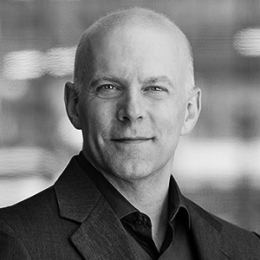 School of Dance Director Luc Vanier
School of Dance Director Luc Vanier
On November 21st thru the 23rd, Repertory Dance Theatre presents “Sounds Familiar,” a concert featuring new work by local choreographers using beloved classical music.
Luc Vanier, director of the School of Dance at the University of Utah is one of the selected choreographers. Working with the second movement of Beethoven’s “Symphony No. 7,” which was composed in 1812, Vanier tells the story of two people in a post-apocalyptic world.
“I can’t possibly make a new work without acknowledging climate in some way,” Vanier said. “So, you have this big, beautiful music and yet this very stern subject of what may happen if we don’t heed the warnings or if we don’t get together to address this crisis in some way. We’re looking at a couple who survived, have a vague memory of a time and are negotiating this moment.”
Vanier’s piece finds dancers Lauren Curley and Dan Higgins in a space with a beat-up old TV, through which Beethoven’s music plays. They are clad in FEMA raincoats. Around them, images are projected – everyday things that have also somehow withstood immense natural destruction.
For Vanier’s collaborator, filmmaker Kym McDaniel, footage of these ordinary objects becomes quite eerie when considering they may outlive humanity. “Kym was in Wyoming when we were discussing the piece,” Vanier said. “Just outside her window were these giant sprinkler units on wheels, passing by. What is the world that has gone on after us? It’s the small things, you know? There is no longer any water, but the sprinklers are still turning on.”
Beethoven’s symphony in the piece reflects this same forgotten feeling. Vanier said, “It is not playing beautifully in the house. In fact, at one point Kym scratched up the sound so much you could almost not hear the melody.”
The movement vocabulary Vanier and the dancers created sprung from real-life images. They began crafting phrases inspired by actions like distinguishing fire, or guiding someone who couldn’t see. The choreography blends the classical and the distorted. Vanier would carefully listen to the symphony, then forget it for a while, piecing the elements together as they developed. It is exactly this kind of reinventing an iconic score that gives Beethoven new life more than 200 years since it’s creation. This evening of 21st century choreography will reinvigorate the work of Bach, Puccini, Haydn, Mozart, Prokofiev, Khachaturian and more.
“Sounds Familiar” features 12 choreographers, including School of Dance Assistant Professor (Lecturer) Sara Pickett, Faculty Emeritus Stephen Koester, Faculty Emeritus Sharee Lane, Assistant Professor Molly Heller and dance alumni Nicholas Cendese, John Mead, Nathan Shaw, and Natosha Washington. Repertory Dance Theatre company members Daniel Do, Elle Johansen, and Ursula Perry are also alumni of the University of Utah School of Dance and will be featured in the concert.
See “Sounds Familiar!”
November 21-23 at 7:30 PM
Rose Wagner Performing Arts Center
Tickets $30, Students $15
Get tickets here.
Utah Ballet opens Thursday October 31st at the Marriott Center for Dance. This is the first of a two part concert series showcasing the strength and versatility of the U’s ballet program, featuring an eclectic mix of ballet classics and fresh choreographic works.
“The language of ballet has been evolving throughout generations and this is reflected in the repertories of countless ballet companies around the world,” says concert director Pablo Piantino. “As faculty members of the School of Dance, we have a responsibility to introduce and challenge our students, and our community, to these trends and changes in the field.”
Utah Ballet’s program includes the second act of Giselle, choreographed in 1842 by Jean Corelli and Jules Perrot and masterfully restaged by Assistant Professor Jay Kim. This ghostly romantic tale of deceit, forgiveness and the triumph of love will surely be an audience favorite. On the other end of the spectrum, as an African American artist committed to dance for social justice, Charles O. Anderson offers (Re)current Unrest We the People, a work that gives testimony through contemporary-dance expressions of the African Diaspora, performed by students from both the Ballet and Modern programs.
Alejandro Cerrudo is a choreographer sought after all over the world, and his piece Second to Last has been set on the students by School of Dance Assistant Professor Pablo Piantino. “It is truly a treat for me as a re-stager to be able to set Second to Last on our students, a work Alejandro choreographed for Ballet Arizona several years ago,” says Piantino. “When I asked him what the work was about he said, ‘…relationships perhaps, I’m not sure. I think the dance should speak for itself.’"
The final work of the program is Carmina Terra, choreographed by Susan Jaffe, one of America’s greatest ballerinas. Declared by the New York Times as “America’s Quintessential American Ballerina” Jaffe was a principal dancer with American Ballet Theatre from 1980-2002. Jaffe presents a challenging, yet fulfilling ballet that will further showcase our dancers’ ability to perform at the highest levels.
“The inspiration for Carmina Terra (Earth Songs) is inspired by the natural spirals in nature. You see these spirals in seashells, the way water spirals going down a drain, and the spinning spiral of the galaxy. These types of spirals twist and turn within the choreography, and coupled with the transcendent contemporary music, creates an otherworldly environment of rhythm, detail, and kinetic force.”
Utah Ballet Runs October 31 – November 7 at the Marriott Center for Dance
Tickets can be purchased online at tickets.utah.edu
Current U students get in free with ArtsPass! (UCard)
University of Utah’s Utah Philharmonia will channel the mystique of supernatural folklore at this year’s “Haunted Orchestra: Myths and Legends,” Oct. 24-25 in Libby Gardner Concert Hall.
For 18 years the Utah Philharmonia has delighted audiences with its annual Halloween concert. In previous years the orchestra performed scores from "The Phantom of the Opera” and “Star Wars,” becoming an anticipated favorite and family tradition. This year the orchestra will perform selections from the movie “Thor,” Disney’s “Beauty and the Beast,” Gustav Holst’s “The Planets,” plus other Halloween favorites.
U School of Dance has been collaborating with the Haunted Orchestra since 2004 featuring a variety of works over the years including excerpts from “Star Wars” and “The Firebird.”
Student choreographers Emma Furukawa and Sana Tepley have been working on developing choreography to accompany "Uranus, The Magician" from Holst's “The Planets” as part of the concert. Seven dancers will make use of the spectacular space in LGCH to entertain the audience with Harry Potter-inspired choreography.
The entire orchestra will be dressed in costume including the conductors. Attendees are encouraged to wear their costumes too. The annual costume parade will showcase audience members of all ages. Concert starts at 7:30 p.m.
Admission is $12.50 for adults and $6.50 for students and children/faculty and staff/seniors. The event is free for U students through Arts Pass a.k.a their Ucard. Tickets may be purchased from Kingsbury Hall Ticket Office, at the door, or by calling (801) 581-7100. For more info visit, tickets.utah.edu.
Stay Connected: Shannon Mostrom
Shannon Mostrom earned dual Bachelor’s degrees from the University of Utah, her BFA in Ballet and her BS in Business Entrepreneurship from the David Eccles School of Business.
While at the College of Fine Arts, Mostrom was included on the Dean’s List and took part in the Business Scholars Program, the David Eccles School of Business (DESB) Exchange Program in South Korea and Paris, the Women in Business Club and the Ethics Club. After graduation, she went on to earn her Masters in Finance at the Hult International Business School in London. She wrote a piece on the Hult blog on how ballet prepared her for business.
Mostrom currently lives in New York City and works as a Media Associate at VaynerMedia. We caught up with her to learn more about how her path has progressed since her time on campus.
You double majored at the U in Ballet and Business. What made you choose this blend of studies and was it always the plan in your mind?
I have always loved to dance, I started at the age of two and began taking it seriously around twelve. I knew from a young age that I wanted to study it in college and I was attracted to the University of Utah's ballet department because I knew I would receive intense technical training and ballet performance opportunities. Another aspect of the U that I liked was that I was able to double major. I come from a business family so I was interested in learning more about business and enjoyed the creativity behind the Entrepreneurship degree. For a while, I struggled between choosing to study marketing or entrepreneurship but when I learned that I was able to fit the entrepreneurship degree in four years it weighed heavily on my decision.
Favorite memories of the U?
• Performing in "Serenade" freshman year
• Studying abroad in Paris and South Korea with DESB
• Teaching at the University of Panama with the School of Dance
• Skiing, camping, and hiking on the weekends in SLC
• Weekend choreography rehearsals with friends
What was your mindset when you graduated? What influenced your decision to pursue a Masters in Finance?
I was looking forward to continuing my business education and living in a new city upon graduation. The majority of my time was spent on training and performing while in Utah and I was excited to focus on one area. I knew that I wanted to study Finance in graduate school because it is the backbone of business and it helped me understand the big picture. 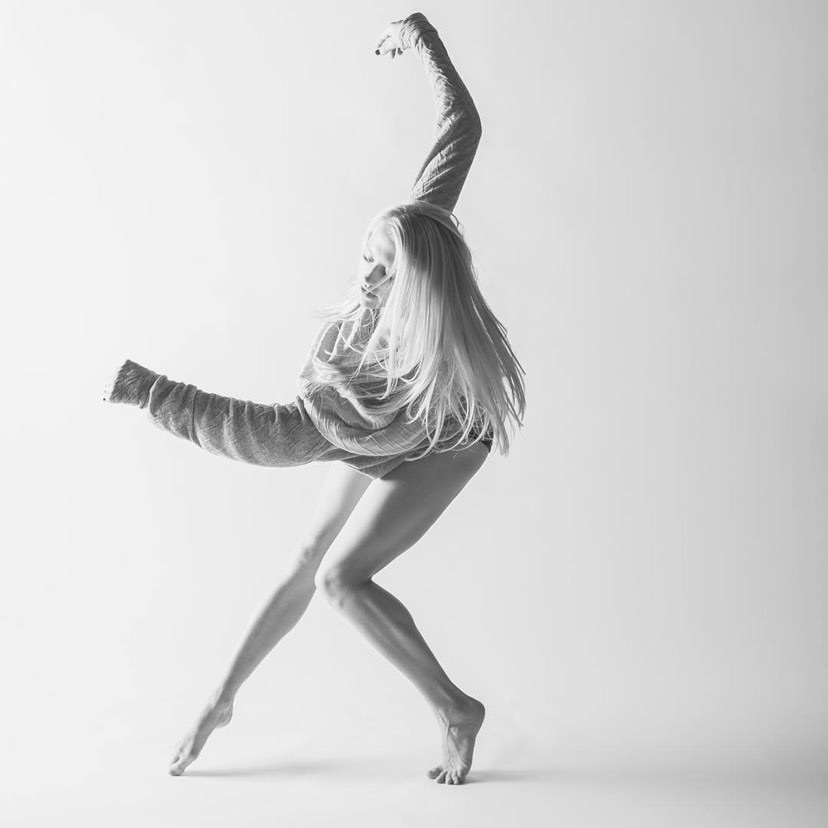
What does dance mean in your every day now?
Every day I use skills that I have developed over the years from dance, some of them being discipline, openness, and resilience. Dance taught me the importance of pushing through failure, exhaustion, and self-doubt, which directly translated to learning difficult subjects, presenting material to a class, pitching ideas to a client and interviewing for jobs. At the same time, dance taught me self-awareness and openness. Dance exposed me to a variety of backgrounds and experiences that pushed me to develop empathy and compassion for people that were different from me. This has helped me relate to strangers in new cities, connect with coworkers and classmates, all of which helped with my moves over the past several years.
What is your favorite place to live so far?
While I miss living in the mountains I would have to say that London and New York have been my favorite places to live. I love the energy of the city, culture, and the mindset of the people working here.
Proudest moment from your career?
One of my goals in going to graduate school was to position myself on the east coast to get a full-time job in NY. Landing a full-time job here last March was a milestone that I was very excited about.
We love connecting with our alumni and hearing about how their lives have transformed since graduation.
Are you an alum of the College of Fine Arts and want to connect?
Fill out this online form and share your news and advice!
Guest Artists Omar Carrum and Charles Anderson Leave Lasting Impressions on the School of Dance
This semester, the School of Dance hosted guest artists Omar Carrum and Charles Anderson, whose work will be shown this week in Performing Dance Company’s fall concert, opening this Thursday in the Marriott Center for Dance. In brief but powerful residencies on campus, these artists left more than just polished works behind. The philosophies and experiences they shared with dancers continue to have lingering impact beyond the stage and studio.
Hailing from Mexico City, choreographer Omar Carrum collaborated with the students to create “Alchemy of the 7 Elements,” an elegant journey through the dancers’ memories and beliefs. “I've been researching how to use our deepest emotions without them disturbing or hurting us while accessing them -- to be able to go in and out, using just a drop of sincerity in the process,” Carrum said. “I think of movement as reactions of what’s happening inside.” 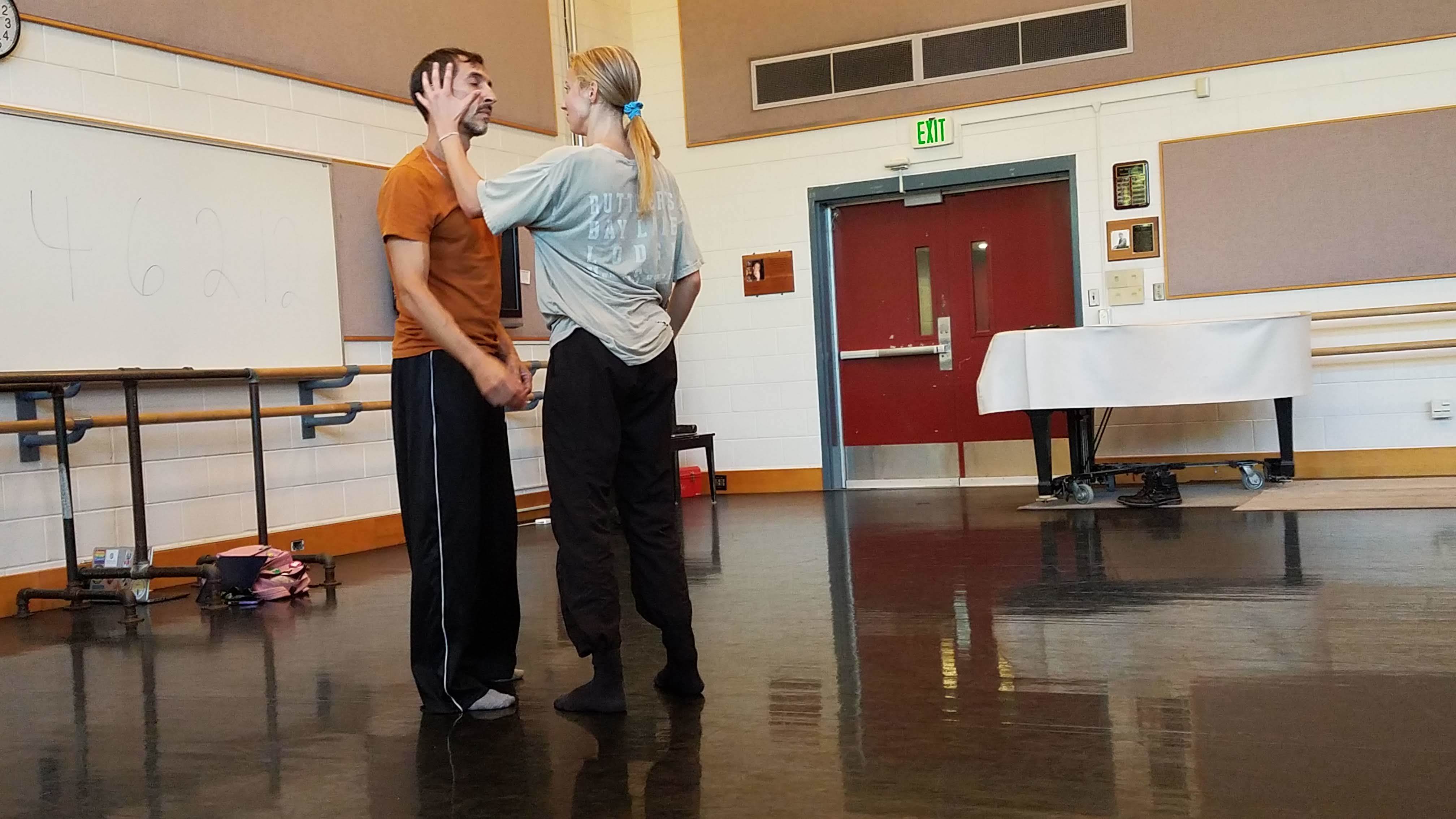 Omar Carrum partners with School of Dance student
Omar Carrum partners with School of Dance student
While in the studio, Carrum worked with “the development of fictional characters based on real experiences from our past histories, and how those histories interweave with the histories of others.” He asserted, “I truly believe that artists are alchemists that can change any ‘lead’ experience into a ‘gold’ metaphor.”
“So many dance teachers say ‘leave your baggage at the door’ but Omar explicitly asked us to share our baggage with him and each other. Omar helped us develop individual characters by combining different versions of ourselves,” dancer Arin Lynn said. “Personally, I am learning a lot about what identity means to me. By researching these types of questions, we become more alive inside of performance.”
Lynn also found Carrum’s “drop of sincerity” a useful tool in making performance honest but not overbearing. “This idea has affected all of our dancing and I believe it will take me a long time to fully understand that concept,” Lynn said. “However, the drop of sincerity awakened a psycho-physical awareness which has changed my relationship with my own dancing for the better.”
Choreographer Charles Anderson worked with 15 dancers, including both ballet and modern majors, to reconstruct an excerpted version of "(Re)current Unrest," an evening length immersive performance ‘ritual’ built upon the sonic foundation of Steve Reich’s three earliest works. The larger project began as an investigation of legacy, authorship and citizenship and protest through the lens of the erasure of the Africanist presence inside of Reich’s compositions. The excerpted version, “(Re)current Unrest: We Are The People” is a meditation on the increase in racially motivated violence and what it means to be an American.
Anderson wrote, “I am a Richmond, VA born and raised, Black, gay, first-generation, ivy league college educated artist-educator-activist. As a choreographer I am formally trained as a post-modernist. As an African American artist committed to dance for social justice, I am a kinetic storyteller. I approach choreography and dance theatre as metaphor for kinetic storytelling or testimony. I create dance-theatre that is informed and inflected by contemporary expressions of African Diasporic vernacular dance.”
Graduate teaching assistant Alexandra Barbier assisted Anderson in the rehearsal process. For Barbier, Anderson’s work extended far past technique and “steps.” “Parts of the choreography are pretty complicated, but I believe that one of Charles's main goals in setting this work was to build community and to expose us to the unquestioned, sometimes problematic, ideologies within our culture that shape how we learn and perform as dancers,” she said.
When it comes to social activism, the final performance product is not the only place of impact. Barbier continued, “Charles led conversations about race, class, gender, the systems that perpetuate oppression and the questions we should ask ourselves in order to dismantle these systems. I have no doubt that the cast will continue to grapple with these ideas outside of the time spent in the studio... and that is the activism. The audience may not engage with these concepts beyond the 12 minutes they spend viewing the final product, but the knowledge gained in the process will (hopefully) live on and be disseminated by the dancers as they interact with the world.”
Don’t miss the chance to see Performing Dance Company Oct. 3-5 and 17-19. For more information visit dance.utah.edu.

